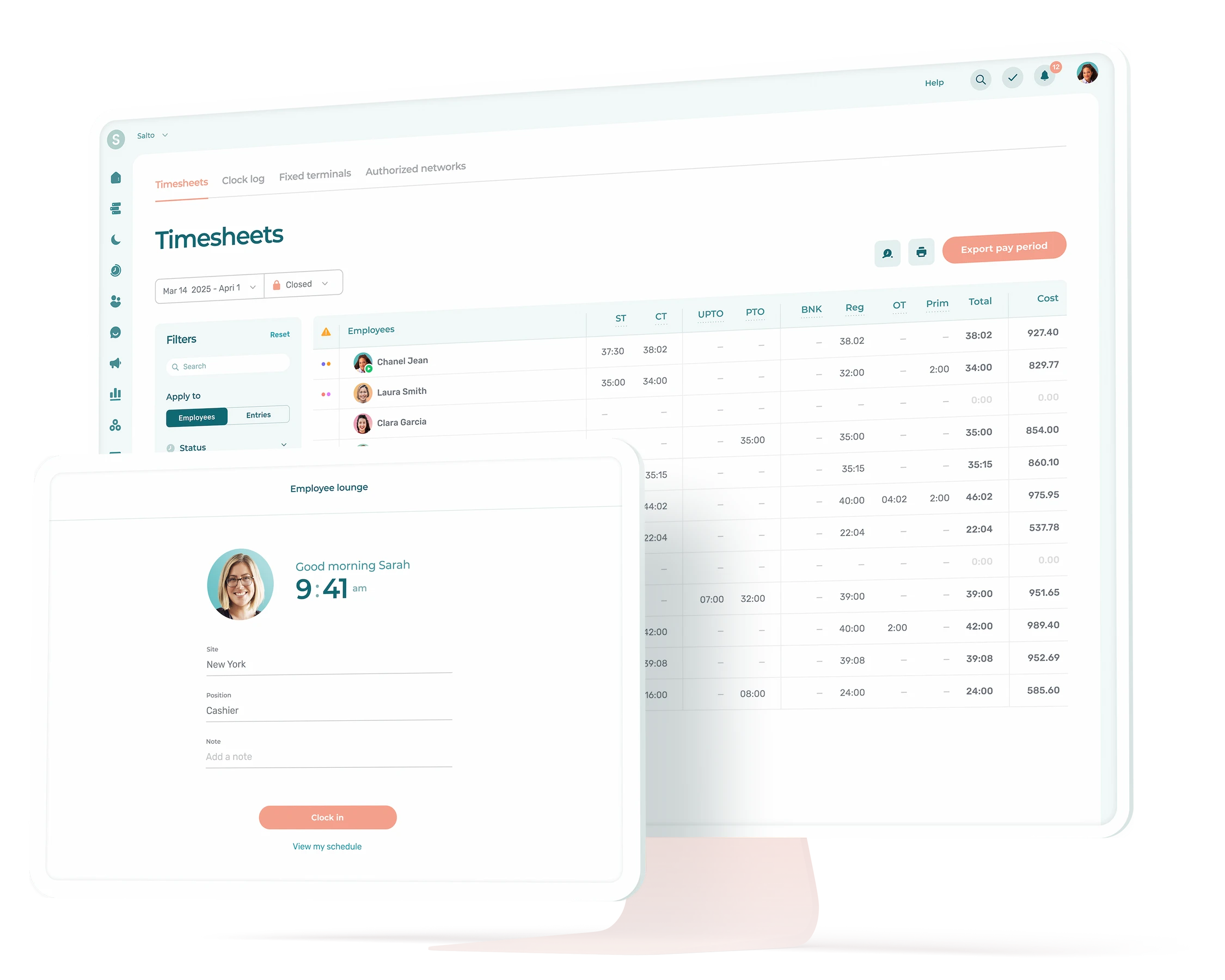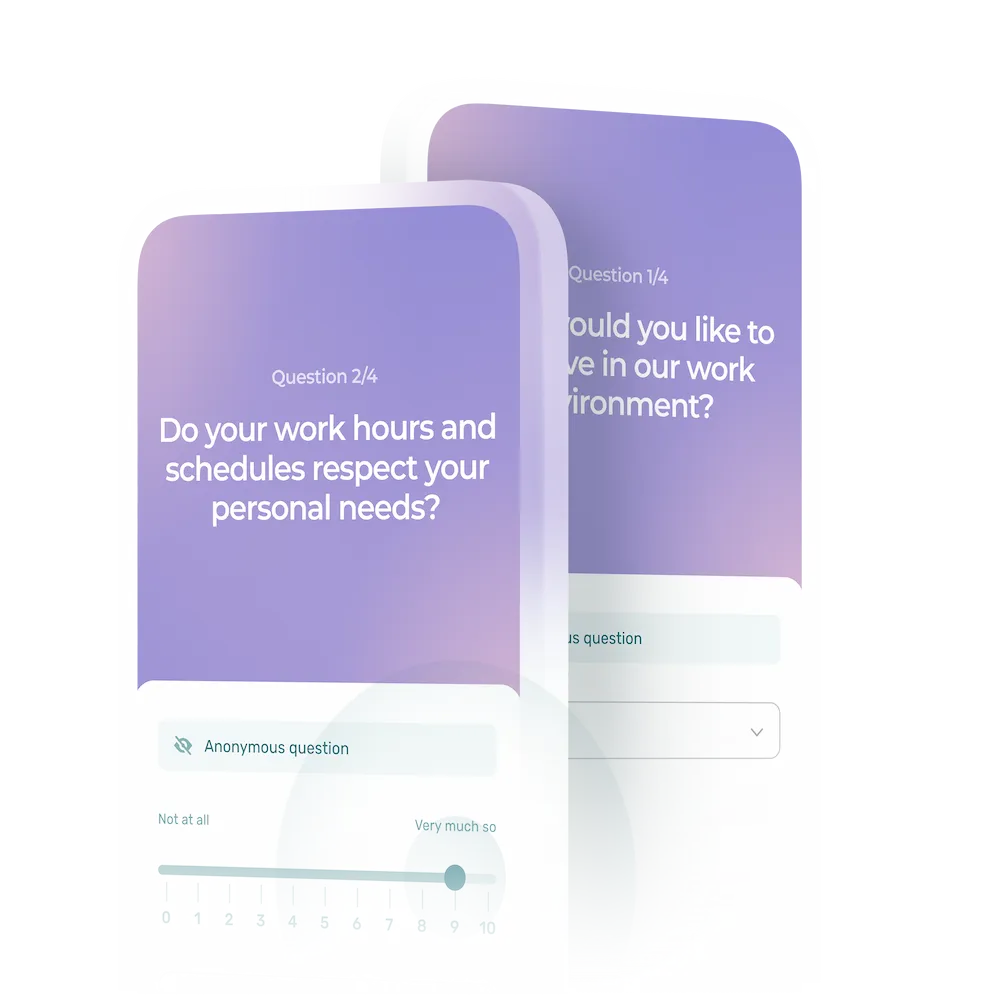Managing overtime is a frequent headache for managers. Although these hours are sometimes necessary to provide continuous service, overtime can harm the well-being of your staff.
Not to mention that the additional labor costs can significantly hurt your company’s bottom line. So how can you better figure things out, track your employees’ workload, and, ultimately, enjoy substantial savings?
This article covers:
- How to calculate your employees’ overtime
- The various laws that apply in Canada
- The challenges that come with managing overtime
- 10 solutions to cut overtime costs at your company
How Do You Calculate Your Employees’ Overtime?
Calculating these hours is fairly straightforward. Simply take it one step at a time. ✅
You can calculate your team’s overtime hours in 5 steps:
1. Define Your Standard Work Week
Based on the laws in effect in your region as well as your company’s policies, establish the number of hours in a full-time work week. Although some companies have a 37.5- or 35-hour workweek, in most cases, the standard is 40 hours per week.
2. Track Your Employees’ Regular Working Hours
Use a punch clock to record the regular work hours of each of your team members.
3. Identify Overtime Hours
Once you’re tracking regular hours, you will be able to quickly identify the hours worked beyond the normal work week for each employee. If your week is 40 hours, anything worked beyond that is considered overtime.
4. Establish Overtime Pay
According to the laws in your region, your employment contracts, and your organizational standards, determine the compensation for overtime hours. This will generally be 1.5 or 2 times the hourly regular rate, but it can vary from one company or region to another.
5. Calculate the Overtime Hours to Be Paid
To calculate everything, multiply the number of overtime hours by the compensation you offer. The formula generally looks like this:
Worked overtime hours x Overtime hourly rate = Overtime pay
Then add this pay to the rest: simply add the total overtime pay to the regular pay for the current pay period.
Example of Calculating Overtime Hours
Regular week = 40 hours
Regular hourly rate = $15 per hour
Overtime rate = 1.5 times the hourly rate
One of your employees worked 45 hours this week.
Regular hours: 40 hours
Regular pay: 40 x $15 = $600
Overtime hours: 5 hours
Overtime pay: (5 × $15/hour) × 1.5 = $112.50
Total pay calculation: 600 + 112.50 = $712.50
Overtime in Canada: What Are the Laws in Your Region?
In Canada, overtime is governed by the provinces and territories. The rules applying to hourly rates, for example, vary depending on your region. So, when determining what you want to implement in your company, make sure to heed local authorities and the labor laws of your province.
Most provinces and territories consider a regular work week to be 40 hours, but there may be exceptions. In all cases, hours worked beyond the normal week are eligible to be paid as overtime, often at 1.5 times the regular hourly rate.
Here are some details for a few provinces, along with government websites you can turn to:
Ontario
In Ontario, overtime starts after 44 hours within the same work week. These hours must be paid at time and a half (1.5 times the regular hourly rate).
More information is available on the Ontario government website.
Quebec
In Quebec, any worker who works more than 40 hours per week is considered to be working overtime. These hours must be paid at time and a half (1.5 times the hourly rate), a 50% increase compared to the usual hourly rate.
For details, visit the CNESST website.
British Columbia
In British Columbia, the normal work week is also 40 hours. However, the province makes a distinction between overtime hours per day vs. per week.
Employees are paid at time and a half for any hours worked beyond 8 hours per day, up to 12 hours. Any hours worked beyond 12 hours per day are paid at double time.
👀 Note that this rule applies even if the employee does not work more than 40 hours per week.
For details, consult the British Columbia government website.
Alberta
In Alberta, all hours worked beyond 8 hours per day or 44 hours per week are treated as overtime. The longer of the two durations is considered: the rule of 8 hours per day or 44 hours per week.
In terms of compensation, the rate is also 1.5 times the regular hourly rate.
To find out more, refer to the Alberta website.
Overtime Hours and Their Management Challenges
Your team’s overtime not only creates a need for calculations and various administrative adjustments, but also raises a variety of other management challenges.
Financial challenges 🤑
Higher Labor Costs
Having more work hours to pay at a higher hourly rate inevitably means higher labor costs. This is something to keep an eye on if you have a smaller profit margin, among other things.
Budgetary Constraints
SMEs or other businesses with smaller profit margins, such as restaurants, struggle with sustaining regular overtime pay. These additional costs can have an impact on the overall financial health of an organization.
Customer Service Challenges 🌟
Lower Service Quality
If your employees are tired and overworked as a result of regularly working 50-hour weeks, it’s more than likely they won’t be able to provide the same quality of service as if they have some time to relax and recover. This has a direct impact on customer satisfaction and can even hurt your company’s reputation.
More Frequent Errors
Fatigue and stress often go hand in hand with an uptick in errors.
Communication Challenges 📣
A Higher Volume of Communications
Because they fall outside your employees’ normal working hours, overtime hours require more communication. Did everyone receive the correct information? Are there any ambiguities to clear up?
Burnout-Related Challenges 🪫
Fatigue and Its Impact on Productivity
Overtime and burnout are unfortunately often closely intertwined. Long working hours will affect focus, stress levels, and staff performance.
A Decline in Work-Life Balance
Tired, stressed-out employees who struggle to find time for their personal activities will see an impact on their well-being and job satisfaction. They are also much more likely to suffer from burnout.
Motivation Challenges 📉
Lower Team Morale
If overtime has become routine for your employees, there’s a good chance that their motivation and morale will take a hit. This can in turn lead to a low retention rate.
Higher Turnover Rates
Your employees may start looking for other opportunities if they feel overwhelmed. With the current labor shortage, you have much to gain by hanging on to your talents.
Staffing Challenges 🎯
Being Unable to Effectively Plan Your Staffing Needs
Using overtime as a long-term solution to offset a shortage of staff will only worsen workforce planning.
Compliance Challenges ⚖️
Non-compliance With Labor Laws
Your business must comply with the laws in place to protect workers with respect to overtime. Violations can lead to stiff fines.
10 Solutions to Reduce the Costs Associated With Overtime
To lower expenses associated with overtime management at your company, we have put together a list of 10 practical solutions.
Scheduling Solutions
1. Review and Adjust Your Work Schedules
Take the time to analyze your work schedules: are there peak times in your business, or are there times when the workload tends to be heavier? If so, adjust your staff accordingly.
By establishing more efficient scheduling practices, you will be able to distribute work more fairly and reduce the number of overtime hours that are required.
2. Implement Flexible Schedules or Compressed Work Weeks
Flexible schedules and compressed workweeks are interesting solutions for your company: instead of working 40 hours in five 8-hour days, employees can work four 10-hour days, for example. This lets you have more staff working during busy times.
Your employees work longer hours on a smaller number of days, which can help reduce overtime. Make sure to follow the labor standards in effect in your region!
💡Before revamping your work schedules, survey your employees to see if these changes work for them. After all, while your main goal here is to save money and reduce overtime hours, you don’t want to do so at the expense of your team’s well-being!
3. Make Good Use of Your Part-Time Employees
Do you hire part-time employees? Use these resources to lend a hand to the entire team. This way, you can reduce the overtime hours that your full-time employees need to work. You have a lot to gain: for example, in addition to the savings, you will be able to respond to leave requests with greater flexibly. You will also be more easily able to find replacements to fill in for last-minute absences.
Work Time Solutions
4. Know the Time Required to Do the Work
Do you know how much time is needed on average to perform certain recurring tasks, such as closing up the store or cleaning the kitchen? The idea here is not to start micromanaging your employees, but to identify tasks that require two people instead of one, or that require additional training.
5. Establish a Clear Overtime Policy
If there is no framework governing overtime at your company, make sure to put a clear policy in place. Communicate your expectations regarding when and how staff can work overtime, how it needs to be approved, etc.
6. Closely Monitor Work Hours and Overtime
Set up systems to track your employees’ work hours, including overtime. For example, scheduling software allows you to see from the get-go if you are planning a week that will exceed 40 hours for your employees. A time tracking and attendance tool will let you accurately track the hours actually worked and compare them with scheduled hours.
Solutions Involving Your Employees
7. Train Your Employees to Be Multi-Skilled
Don’t train your employees for a single role: offer more comprehensive training to build a more versatile team that can pitch in when needed. For example, in your pharmacy, cashiers can be trained to answer customer questions about products, and floor staff can learn warehouse tasks to help out if need be.
8. Involve Employees and Ask Them for Feedback
Your employees know what’s happening in your business: they are with the customers and can see things that you may not have noticed. Involve them in your decision-making and seek out their feedback on the workload and work schedules. If you have implemented changes, you will be able to see if they align with your team’s strengths and preferences. You can kill two birds with one stone and make sure that everything connects with the needs of your clientele.
9. Discuss Potential Alternatives With the Team
Explore new avenues with your employees, such as voluntary time off during slower periods or staggered work hours. You can also see if some employees would prefer to have more time off rather than paid overtime. In all cases, make sure to check the laws in place in your region.
Technological Solutions and Automation
10. Invest in Tech Tools
Implement tools to make your life easier and make significant savings in the medium and long terms. Streamline your work processes, improve your practices, and become more efficient with the various software available.
HR automation is a good place to start: centralize your staff management to free yourself from non-value-added tasks. This will give you more time to support your team, better plan your work schedules, and, consequently, manage your team’s overtime hours more effectively.
Here are some tools to automate overtime management:
Scheduling software
Allows you to create efficient schedules, better plan and identify overtime hours, and communicate more quickly with the team.
Time and attendance management software
Allows employees to punch in and out (arrival, departure, breaks), track their work hours, and automatically calculate overtime with predefined rules. These programs easily integrate with payroll software, minimizing the work required of managers.
Payroll software
Usually includes automated overtime calculation features. These tools can be configured to apply the right overtime rates and ensure compliance with labour laws.
Staff management software
Offers a comprehensive solution for tracking worked hours and attendance, managing work schedules, processing payroll, personnel records, onboarding and integration, etc. These systems can provide data that will allow you to track your labour costs more easily and identify potential areas for savings.
What Is Overtime?
Any work done by an employee beyond the maximum number of hours per week or per day provided by law is deemed overtime. In Canada, a standard work week is typically 40 hours. Overtime laws may vary from one province or territory to another.
How to Calculate Overtime?
To calculate an employee’s overtime, multiply the number of overtime hours by the offered compensation:
Overtime hours x Overtime rate = Overtime pay
Then add the total overtime pay to the regular pay for the current pay period.
What Are Employee Rights When It Comes to Overtime?
Employee rights regarding overtime hours include:
- The authorization to work overtime: employers must first have the consent of their employees before they can require them to work overtime. However, some exceptions may apply in emergency situations.
- Overtime eligibility: all employees can normally work and be paid for overtime, for hours in excess of the regular 40-hour work week. It’s important to check the applicable laws in your region.
- Overtime pay: employees must be paid at the adjusted rate for the overtime hours they work. The standard rate is time and a half (1.5 times the regular hourly rate) and sometimes double time. Overtime is generally paid at the same time as the regular hours an employee has worked for the current pay period. Refer to the laws in effect in your region.
- Overtime tracking: employers must keep records on their staff’s working hours, which includes overtime. This information must be safeguarded and kept available in case of an inspection by local authorities.
- Overtime agreements: some employers make agreements with their employees for flexible work options or compressed work weeks. These arrangements may affect the calculation of overtime, but must still comply with existing laws.
- Compensatory time off: some regions allow employers to offer compensatory time off to their staff instead of paying overtime. Again, refer to current laws to get the right information.
- Exemptions: certain categories of employees may be exempt from the rules that apply to most workers regarding overtime. For example, supervisory and management roles often fall into a separate category.













